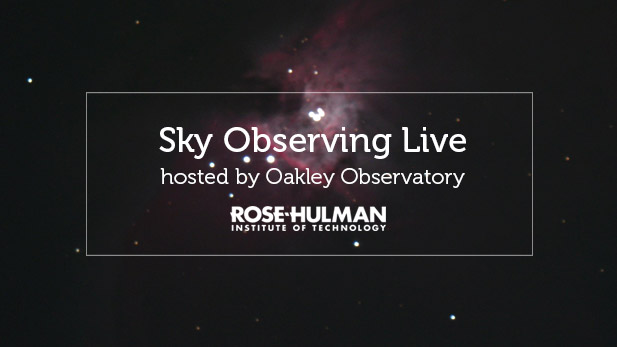Observatory Opening Skies to Online Stargazers

A live Facebook Live stream on Tuesday, April 21, will allow online visitors to view solar and nighttime objects through a telescope from the campus’ Oakley Observatory, set up by director and assistant professor Dominic Ludovici.
Rose-Hulman’s Oakley Observatory is opening the skies for people desiring to take a closer look at solar and dark sky astronomical objects, and learning more about them.
Observatory Director Dominic Ludovici, assistant professor of physics and optical engineering, will be hosting the following upcoming Facebook Live events on the observatory’s Facebook page:
April 21, Live Streaming: A 4 p.m. session will provide solar observing, while a 9 p.m. event will offer dark sky observations, weather permitting. Ludovici will answer online questions and provide commentary about objects being shown through the telescope.
Click here to see what people observed during recent observatory streaming events. These sessions were attended by approximately 1,300 observers.
April 30, Student Presentations: Starting at 4 p.m., students in Ludovici’s Ethics and Communication course will make presentations about their senior research projects. There will be 10-minute talks on astronomy, machine learning, and magnetic nanoparticles. Students are looking forward to sharing what they have learned with the public, according to Ludovici.
May 8, Radio Astronomy Lecture: Ludovici will present a general talk about radio astronomy and discuss how the observatory provides opportunities for students to see new worlds. Details about the time of the discussion will be forthcoming on the observatory’s Facebook page.
“I had recently purchased some livestreaming equipment for teaching and decided to test it at the observatory to see if I could live stream views from the telescope on Facebook. What started as a brief ‘I will test on the solar telescope for five minutes’ event turned into a total of two streams covering two hours,” said Ludovici, who is in his first year leading the observatory. “The (first) solar telescope stream was popular (with 200 online guests) and viewers asked if I would set the camera up on the telescopes for a nighttime stream. I obliged and that stream attracted 1,100 views.”